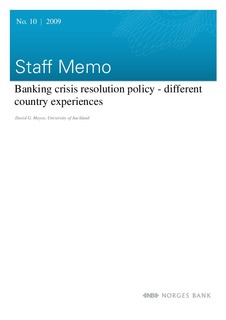| dc.contributor.author | Mayes, David G. | |
| dc.date.accessioned | 2018-08-07T12:54:33Z | |
| dc.date.available | 2018-08-07T12:54:33Z | |
| dc.date.issued | 2009 | |
| dc.identifier.isbn | 978-82-7553-522-9 | |
| dc.identifier.issn | 1504-2596 | |
| dc.identifier.uri | http://hdl.handle.net/11250/2507911 | |
| dc.description.abstract | The current financial crisis has sparked an intense debate about how weak banks should be resolved. Despite international efforts to coordinate and converge on such policies, national policy advice and resolution practices differ. The resolution methods adopted in the Nordic banking crises in the 1990s are generally acknowledged to include important elements of “best practice”. But some of these lessons have proved hard to implement during the current crisis, and new policies have been developed as a response. The UK Special Resolution Regime has added important elements to the resolution “tool kit”. In the US, FDIC has used receivership powers to resolve several weak banks. Other countries have also introduced new resolution legislation. Still, unresolved issues remain. These are discussed below in the context of a review of the resolution methods in the US, UK, NZ and Scandinavia. | nb_NO |
| dc.language.iso | eng | nb_NO |
| dc.publisher | Norges Bank | nb_NO |
| dc.relation.ispartofseries | Staff Memo;10/2009 | |
| dc.rights | Attribution-NonCommercial-NoDerivatives 4.0 Internasjonal | * |
| dc.rights.uri | http://creativecommons.org/licenses/by-nc-nd/4.0/deed.no | * |
| dc.title | Banking Crisis Resolution Policy - Different Country Experiences | nb_NO |
| dc.type | Working paper | nb_NO |
| dc.subject.nsi | VDP::Samfunnsvitenskap: 200::Økonomi: 210 | nb_NO |
| dc.source.pagenumber | 76 | nb_NO |

